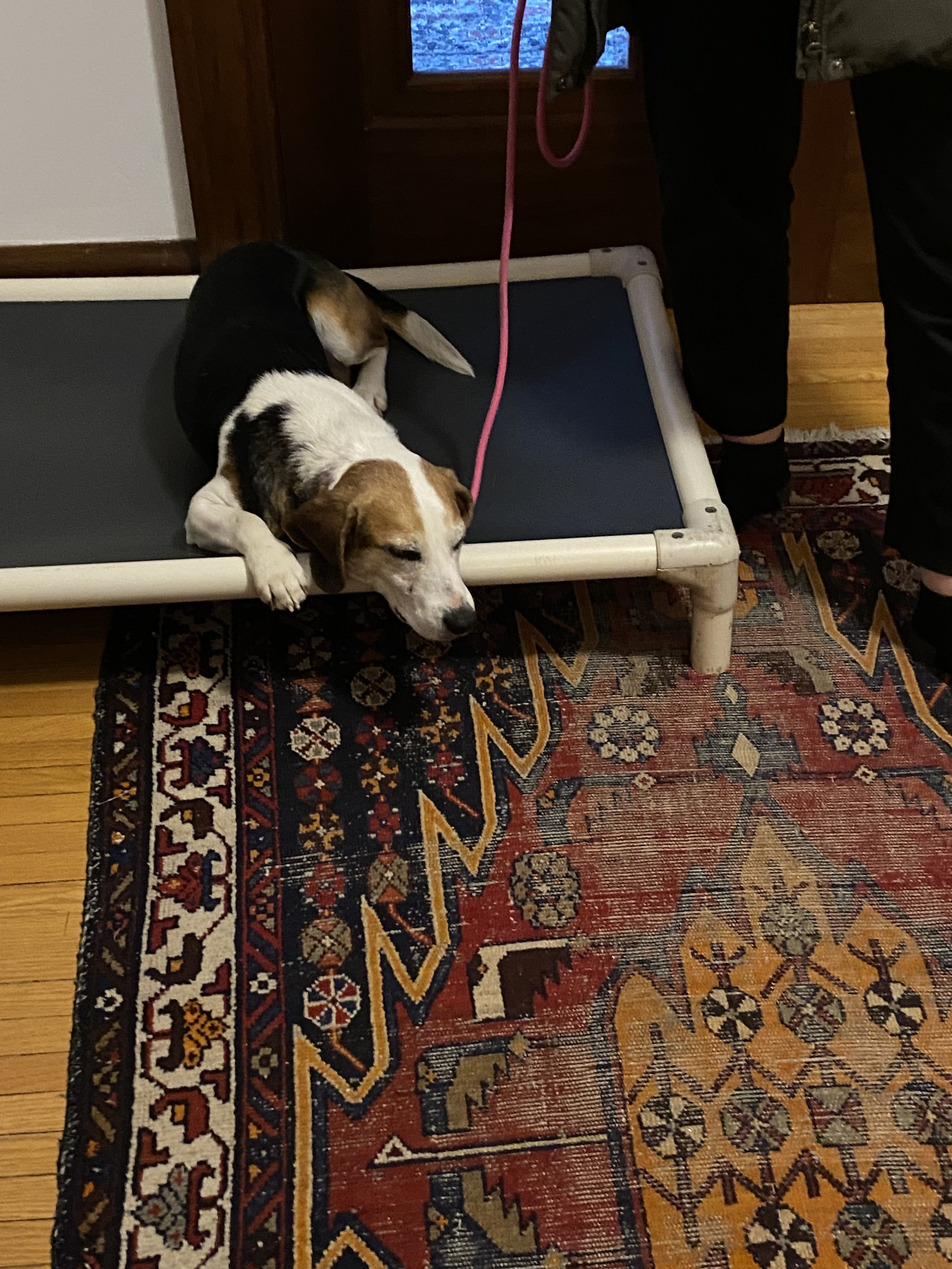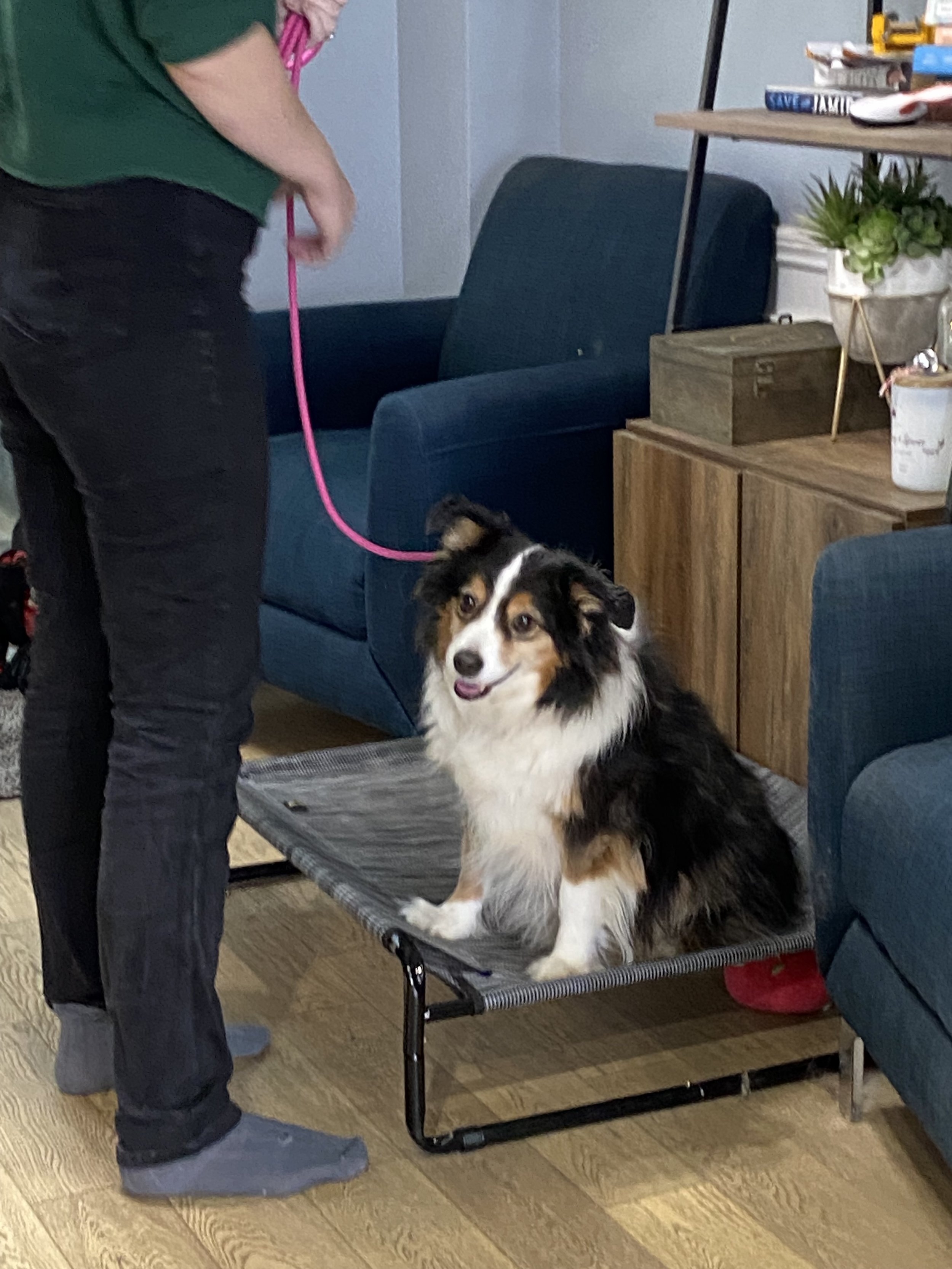Want your dog to leave that ornament or decoration alone? Read on! (Photo: dog wearing a Santa hat yawns at the camera)
Does your dog grab holiday decorations and run around the house playing a frustrating game of keep-away?
Does he scare you when he growls and guards the items that he steals?
Perhaps he likes to also practice this outside in your yard. You’re scared that he’ll hurt himself swallowing bits of sharp plastic.
Why isn’t shouting “leave it” or “drop it” working? Read on for tips to get clarity for yourself and your dog.
Teaching your dog “leave it” will clearly communicate that countertops and tables are off limits (Photo: star-shaped gingerbread cookies with white icing on a countertop)
If you have a puppy or a dog, it’s so important to teach them these important life-saving commands: “leave it” and “drop it.” The important part of that sentence is “teach them.” Many new pet parents follow their puppy around yelling “leave it” when the puppy grabs a shoe, starts chewing a couch cushion, or snags a Christmas ornament. Yelling doesn’t help. Imagine if math teachers simply yelled at their students: “wrong” every time they answered a question incorrectly. There’s no teaching going on there and no one would learn anything, other than “this human yells a lot.”
“Leave it” and “drop it” are different from each other. Read on to learn why you should teach your dog both of these commands.
When your dog knows “drop it” or “aus,” fetch becomes a lot more fun for both of you (Photo: Golden Retriever holding a spiky blue ball in his mouth)
Do you know the difference between “leave it” and “drop it?” If you’re not sure, then you’ve come to the right place. After all, if you’re confused about which is which, then your dog is confused too.
These two commands, along with recall (teaching your dog to come to you no matter what) are three of the most important things you should teach your dog.
“Leave it” communicates to your dog “don’t touch that with your mouth.” It could be toxic for your dog (joints, edibles, grapes, chocolate, etc.) or simply something you would like to enjoy later on yourself (like the steak on your countertop or the butter tarts on your kitchen table.) This same command applies to dead things on the ground, bunny poops, goose poops, and, you get the idea.
“Leave it” allows you to pick up the ball, without your dog snatching it up and playing keep-away (Photo: Border Collie lying on the grass looking at a tennis ball a few feet away from her)
Be sure to check out our 10-part series on teaching the “leave it” command featuring Missy Marcus, a one-year-old Australian Shepherd. Find us on TikTok @BeyondDogTraining. Find us on IG and FB @GoBeyondDogTraining.
“Leave it” is a transferable skill. Once your dog understands what it means, you can communicate to your dog not to pick up: their leash, kid’s toys, clothing, garbage on the ground, food in your toddler’s hand, dinner on your table, etc. It even works on squirrels.
You may wish to use “leave it” for squirrels as well. Whatever you choose, be consistent. (Photo: a black squirrel and a grey squirrel eating nuts on a lawn)
Drop It: Drop it, or Aus (which is German for drop it/out,) is the command you teach so that your dog knows to drop things out of her mouth when you ask. This could be a dead thing she picked up on a walk, your children’s toys, her ball (during fetch, so you can throw it again,) her bone (so you can inspect if it’s still safe to chew), another dog’s toy, your remote control, etc.)
If your dog knows “leave it” and “drop it,” your cat and rooster will finally be able to play in peace (Photo: a calico cat and a rooster looking at a bb-8 droid toy on the kitchen tiles)
The earlier you teach these commands the better. It’s far easier to teach your dog to never touch steak on the counter from day one, than it is to train them not to once they’ve developed a habit of it (and get a very tasty reward of steak every time they do!)
All dogs can learn these commands regardless of how old they are. It’s never too late to begin training your dog. I promise you, he’s smarter than you think.
It’s never too late to teach your dog these life-saving commands (Photo: senior Collie holding a dirty tennis ball)
Have a wonderful holiday season, Dog Leaders!
Alyssa
Photos by:Danny Bezak @harvison (dog wearing a Santa hat yawns at the camera,) Lydia Matzal
@lydia_matzal (star-shaped gingerbread cookies with white icing on a countertop,) Elisa Kennemer @elisalou (Golden Retriever holding a spiky blue ball in his mouth,) Robin Jonathan Deutsch @rodeutsch (Border Collie lying on the grass looking at a tennis ball a few feet away from her,) Claudia McMahon @scmcmahon (a black squirrel and a grey squirrel eating nuts on a lawn,) Daniel Tuttle
@danieltuttle (a calico cat and a rooster looking at a bb-8 droid toy on the kitchen tiles,) Tadeusz Lakota
@tadekl (senior Collie holding a dirty tennis ball)
Updated: December 2025




























































